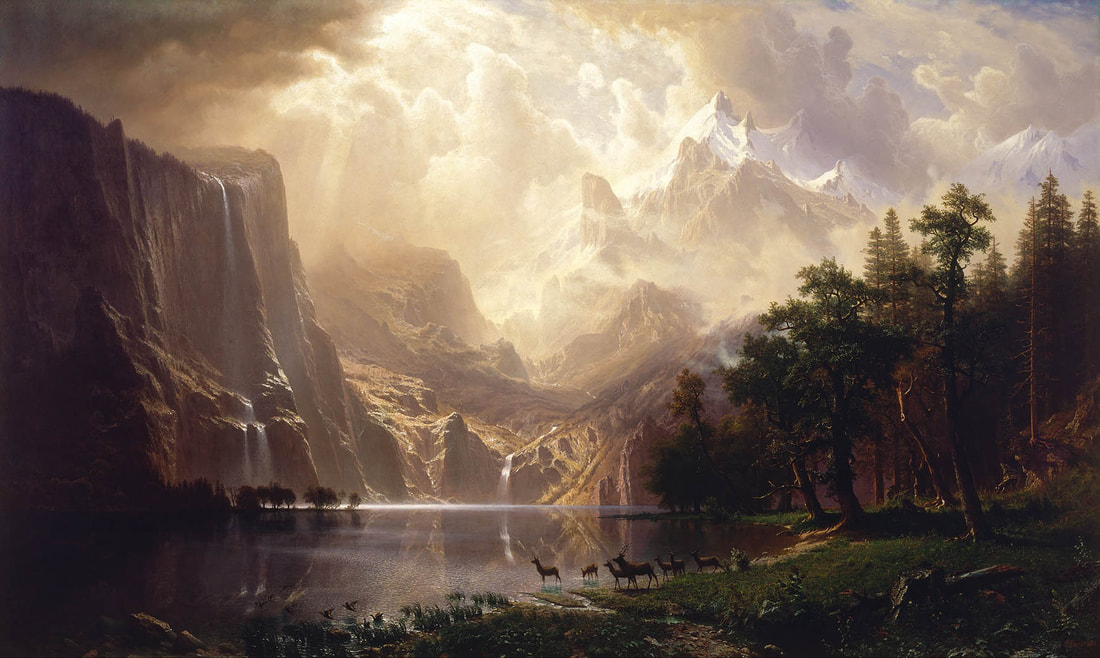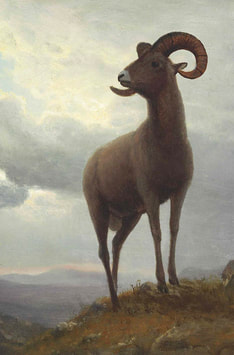 Albert Bierstadt’s family had emigrated to the United States from war-torn Prussia in the 1830s, settling in the seaside village of New Bedford, Massachusetts. Young Albert’s imagination and heart, however, were always drawn to the hills. Venturing first into New Hampshire’s “prodigious hilltops,” he hiked the White Mountains, scaling Mount Washington in 1852 (at age 21), and returning various times to Franconia before the Civil War. Albert’s love of light and mountains led him to the Hudson River, and “the mighty mountains of New York,” where he painted alongside a second generation of Hudson River School artists. He took time to return to Europe and study in the Swiss Alps, but as early as 1859 he joined an expedition to “the snow-capped Rockies” with government surveyor Frederick Lander, and thus began a life-long love affair with the American west. He described the Rockies as “the best material for the artist in the world.” Bierstadt painted big: epic landscapes that inspired awe. His Rocky Mountain Landscape, Lander’s Peak wowed Americans and Europeans alike. In 1863, the thirty-year-old Bierstadt sold the six foot by ten foot canvas for $25,000, the equivalent of $400,000 today, a staggering sum for a young artist. And he was just beginning. The same year that he finished “Lander’s Peak,” he went west with a friend to visit California’s Yosemite in “the curvaceous slopes of California, ” the Sierra Nevada range. He forever memorialized its grandeur in luminous renderings of the Valley of Yosemite; these stunned and enraptured viewers. It is possible to criticize Bierstadt for idealization of the Sierras. But some of the region’s earliest explorers, such as John Muir, shared his sense of these mountains as a nearly religious experience, a “Range of Light,” in which “the whole body seems to feel beauty when exposed to it as it feels the campfire or sunshine, entering not by the eyes alone, but equally through all one’s flesh like radiant heat, making a passionate ecstatic pleasure-glow not explainable.” “These blessed mountains,” Muir wrote, “are so compactly filled with God’s beauty, no petty personal hope or experience has room to be.” The mountains were an experience of promise and awe after a time of horror. For the next forty years, Bierstadt, the gifted immigrant from Germany and child of New England shores, found his subject in the grandeur of the American west. He painted the Grand Canyon and the Wyoming range. His first journey west of the Mississippi had taken place in 1859, when buffalo herds were in the millions. By the 1880s, the animals were nearly extinct. His “Last of the Buffalo” (1888) called attention to the loss. At the time the painting was criticized for “marring” a perfectly good landscape with close-ups of “savages,” that is Native Americans hunting. But Bierstadt was committed to capturing the whole of the American experience – landscape, bison, and native peoples -- with dignity, precision, and concern for the future.  A New Yorker (by this time) and an advocate for wildlife preservation, Albert Bierstadt became a close friend of not-yet-president Theodore Roosevelt, who in the 1880s embarked on his own love affair with the west in the Black Hills. Back in New York, Bierstadt and Roosevelt worked for legislation to prevent poaching of the bison in Yellowstone (established as a national park in 1872). TR’s imagination was fired by Bierstadt’s paintings of Yosemite, and as President, he embarked on a camping expedition with naturalist John Muir that resulted in preserving Yosemite as a national park as well. National park legislation has been one of the great acts of stewardship undertaken by the American people, and the paintings of Albert Bierstadt heightened awareness of these unique wonders. This month, as we vote (and work to overcome rancor), we should remember that we've been through worse times. Let's call student attention to the virtues of gratitude, wonder, and stewardship. Bierstadt's work sprang from gratitude and wonder, and inspired better stewardship. Here's to mountain majesties, and let freedom ring! To read more from Telling Our Stories, visit our Blog Archives page. Comments are closed.
|
AuthorWrite something about yourself. No need to be fancy, just an overview. Archives
July 2024
Categories |
